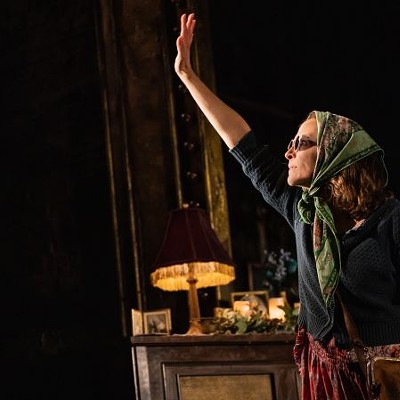In Janet Cardiff and George Bures Miller's installation "The Infinity Machine," a cluster of mirrors dangles from the ceiling, slowly rotating in the darkened interior of The Menil Collection's Byzantine Fresco Chapel. There are oval mirrors, gilt mirrors, beveled mirrors, wall mirrors, hand mirrors, in all shapes and sizes. Some are vintage, some are antique. In the center of the mass, two mirrors face each other, reflecting infinitely.
The mirrors hang from the dome of the chapel, where, a few years ago, a visitor would look up and see a 13th-century fresco depicting Christ Pantocrator ("ruler of all"). Illuminated by just a couple of small spotlights, the dozens of mirrors reflect darting and flickering light across the walls and over visitors. A haunting, otherworldly hum of sound emanates from eight speakers around the room. At intervals, a voice counts to eight. The "audio collage" is truly otherworldly, incorporating recordings collected by the Voyager I and II probes as they passed the outer planets of our solar system. The sounds are recordings of solar winds striking the electromagnetic fields of Jupiter, Saturn, Uranus and Neptune. It's like the spaceship equivalent of driving through a neighborhood with your windows down.
The Byzantine Fresco Chapel has stood empty for the past three years after the frescoes it was designed to house were returned to Cyprus. The frescoes had been looted from a Cypriot Orthodox church and then offered for sale in 1983 to Dominique de Menil by a dealer in Germany. De Menil was suspicious and launched an investigation to discover the origins of the 38 fragments. She learned from the Cypriot government that the frescoes had been stolen; the jagged pieces shown in the dealer's photos were hacked out from a chapel in Turkish-occupied Lysi. The Menil Foundation proposed to the Holy Archbishop of Cyprus that it purchase the frescoes on behalf of the Greek Orthodox Church of Cyprus. The foundation covered the purchase price and all attendant restoration costs in return for permission to exhibit the frescoes on a long-term loan. The Menil's Byzantine Fresco Chapel, designed by François de Menil, opened in 1997. The Church decided not to extend the loan beyond 2012, whereupon the frescoes were returned to Cyprus, leaving the chapel empty.
The problem of an empty, purpose-built chapel has since become an opportunity. Organized by the Menil's Toby Kamps, curator of modern and contemporary art, Cardiff and Miller's "The Infinity Machine" is the first in what is proposed to be an annual series of site-specific installations.
There is a sense of quiet awe as you stand in the dim chapel and view the installation. It looks like a galactic model created by some mad 18th--century gentleman astronomer. Suspended from wires, the mirrors are densely grouped toward the ceiling but straggle downwards, like falling stars. The artists collected the mirrors, more than 150 in number, as they scavenged antique shops all over British Columbia, where they live. Each mirror is unique, some of them bearing inscriptions from the original owners who carried them along when they emigrated from Europe.
Each of the hundreds of mirrors has its own patina of use and age, bearing the streaks, smudges and fingerprints of hundreds of owners, carrying particles of dust from hundreds of different rooms. Is there DNA in a faint spatter of toothpaste? The mirrors become individuals, or maybe they just represent all the individuals who have gazed into them. You wonder what it would be like if those mirrors could play back everything they have witnessed -- all the primping, crying, smiling, grieving, grimacing faces that have looked into them, all the intimate acts and spaces they have reflected.
A lot of artists use found objects. Objects carry the weight of cultural and emotional associations, and they can be tricky to work with. Their power can overwhelm an artwork; the objects can be far more interesting in themselves than in the context of the work. Here, however, Cardiff and Miller have played it well. What the individual mirrors bring to the installation only enriches the whole.
There are installations that you can absorb fairly quickly and don't care to linger in, but "The Infinity Machine" makes you want to immerse yourself in the mesmerizing theatricality of the space. The chapel is slightly disorienting but hypnotic, as the mass of mirrors slowly but steadily rotates, the beams of light flitting around the room. Occasionally a fractured glimpse of your own face appears. You can feel the bass from the sounds of space vibrate slightly in your bones, like aftershocks from the Big Bang.
When I visited the installation on a weekday around lunchtime, there was a man in a business suit walking around looking as if he'd just left an office and would soon be returning to one. He sat down on a bench. When I looked up from my notes 30 minutes later, he was still sitting there, staring at the slowly circling work. He was still sitting and staring when I left.
I don't know what future artists will propose for the Byzantine Chapel, but Janet Cardiff and George Bures Miller's "Infinity Machine" is a marvelously successful transition for the space. There is a lot of good art that doesn't fit within the Menil's historic focus on art and spirituality. However, "The Infinity Machine" does, managing to evoke a kind of expansive celestial spirituality that feels like the next step beyond the culturally specific religiosity of the Byzantine frescoes. An Eastern Orthodox image of Jesus doesn't resonate with everyone, but the vastness of space triggers some sort of primal awe in us all.
"Janet Cardiff and George Bures Miller: The Infinity Machine" The Byzantine Fresco Chapel, 4011 Yupon, 713-521-3990.





